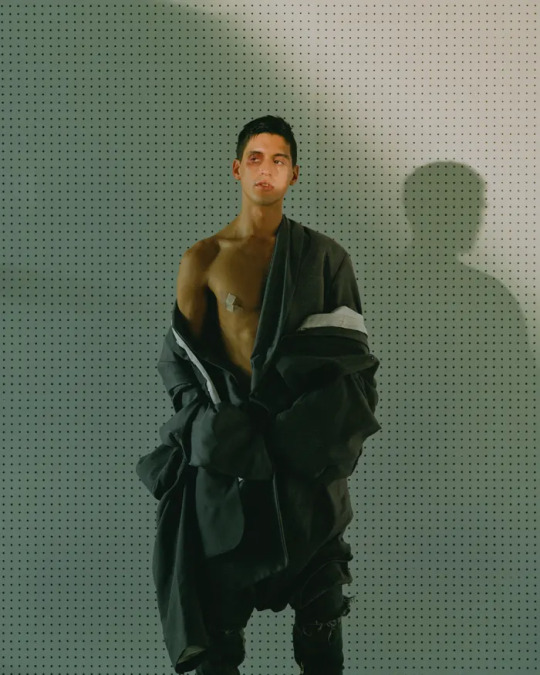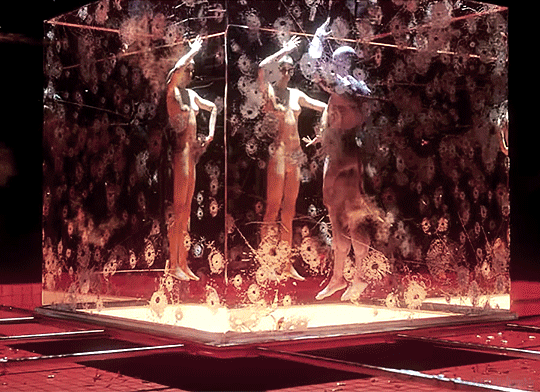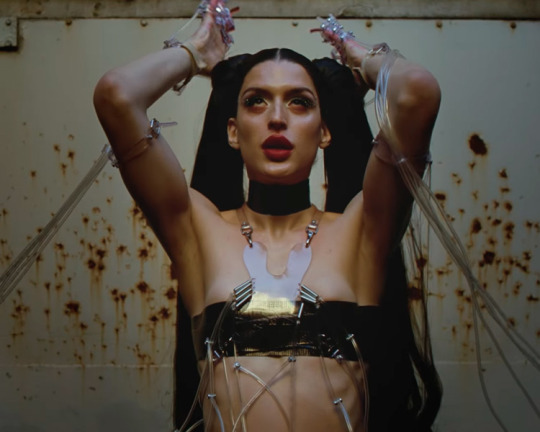Text
Arca: A Visual Guide
Guiding Questions:
Despite having credits as a producer under artists like Kanye West, Björk, FKA twigs, and even more recently DJing for Beyonce’s Renaissance Tour, why is Arca still so unknown in the music industry? Can it be as a result of oversaturation or something more?
If the posthuman references a world without humans or after humans, why is Arca consistently the only human inhabiting the posthuman worlds she creates in her music videos?
What is the purpose of vocal distortions in music in general? Are they designed to hide or to conceal? And in Arca’s use of distortions specifically, are they being used to conceal her voice, her message? How can they contribute to her messages?
If music is an outlet and platform for the expression of alternative narratives like Arca’s, does media in general and story publication outlets have an obligation to also platform the weird and the non-normative?
0 notes
Text
Traditions of Gender: An Overview of Daddy Yankee's "Gasolina"
Reggaeton music is often dominated by the images of either the hyper masculine and/or the hyper feminine, they can however coexist, although primarily in the traditional productions of male reggaetoneros.
The music video of Daddy Yankee’s 2004 hit, “Gasolina” is one of the most prominent examples of this intersection, in which there is a visible (as well as audible) meeting of masculine and feminine extremes.
youtube
Daddy Yankee’s hyper-masculine presence in “Gasolina” is blatant as the singer of the track as well as his role in the music video as the only significantly featured male. Despite being dressed plainly in a denim jacket and jeans, his body language is assertive and the dominance of his appearance is only supported by the camera’s consistent centering of his face and upper body (even with a background full of women).
The 2022 article “Reggaeton music videos on YouTube: Policies on gender stereotypes” emphasizes this point through a slightly statistical lens, in which they collect data from music videos across the YouTube platform. The authors use the videos of Daddy Yankee, Anuel AA, and J. Balvin (who are some of the most recognizable names in the reggaeton genre) to collect their data and perform their analysis on. Their article describes a very similar finding of the dominance and sexism present in these videos, “We observe a great difference between the stereotypes of women and men, the dominance of men's roles over those of women is maintained,” (Carpio-Jiménez, et. al 4). It re-affirms the existence and maintenance of this hyper-masculine imagery, however they overlook the significance of the female presence. The women in these videos are often scarcely clothed background dancers or love interests, “the following stereotypes for women were determined: sexual object, sexy figure, submissive, fun complement, among others” (Carpio-Jiménez, et. al 4). And I don’t think they’re wrong in their conclusions, but I think they are also more nuanced than what this article describes as being, and I think a consideration of their agency in these videos is necessary.
Coming back to Daddy Yankee, we see in “Gasolina” that the traditional role of femininity in reggaeton is that of the dancer to be objectified by the dominant figure of the man, his particular portrayal in the early 2000’s complicates these traditions by confronting them through the quasi-dominance of the featured dancers.

The traditional role of femininity in reggaeton is that of the dancer to be objectified by the dominant figure of the man, but Daddy Yankee’s particular portrayal in the early 2000’s complicates these traditions by confronting them through the quasi-dominance of the featured dancers.
Female background dancers become an integral part of reggaeton music videos, yet the focus on their bodies in these is undoubtedly an example of the music industry’s commodification of femininity. While Daddy Yankee was fully clothed, the women of the video are much more exposed in bathing suits and micro-skirts. Their physical role is therefore defined by their bodies, and even lyrically they contribute little besides a collective, “Dame mas gasolina [Give me more gas]”. There is an obvious objectification of the women, but there is also an underlying theme of agency. They are assertive in expressing their sexual desires and embody a sense of agency by doing so, which does at least begin to subvert traditional notions of femininity and submission.
There is a subtle fluidity of the hyper-feminine and hyper-masculine in this music genre, one which the current generation of reggaetoneros has sought to abandon in order to embrace a more visible subversion of tradition.
1 note
·
View note
Text
Crenshaw's Intersectionality Framework: Arca
Kimberlé Crenshaw is currently a professor at both UCLA and Columbia Law School, who’s published specialities include: Constitutional Law, Civil Rights, Critical Race Theory, and Intersectionality Feminism and Law. And yet, even beyond these specialities is Kimberlé Crenshaw as a scholar and an American civil rights activist, and a pioneer of intersectionality. As both a word and concept, intersectionality recognizes the interconnectedness of individual categories (race, class, gender, etc.) in various forms of oppression; discrimination is therefore not singularly dependent on any of these individual categories.
Kimberle Crenshaw’s “Mapping the Margins” was published in 1991 as part of the Stanford University’s 43rd Stanford Law Review, where she worked at the time. In her 59-page article Crenshaw scrutinizes the content and influence of hip hop music, but only insofar as it becomes a vehicle through which images of black women are disparaged and then disseminated.
Crenshaw specifically references the 2 Live Crew’s production and subsequent performances of Nasty/As Nasty as They Wanna Be because of the tracks depiction of black women as being defined by their sexual promiscuity, “One must worry about young Black women who, like young men, are learning their value lies between their legs. […] Nasty is misogynist, and an intersectional analysis of the case against 2 Live Crew should not depart from a full acknowledgement of that misogyny,” (Crenshaw 1285). Crenshaw denounces music as a reproduction of these deleterious narratives of women (as sexual objects) that simultaneously establish men as forces dominant to them.
youtube
Crenshaw, unlike other prominent feminist scholars like Catherine MacKinnon and Andrea Dworkin, takes this argument further through the integration of her concept of the intersectionality of these oppression-domination narratives, “Black women are "cunts," "bitches," a pose "hos." [..] Those who are concerned about high rates of gender violence in our communities must be troubled by the possible connections between these images and the tolerance for violence against women,” (Crenshaw 1285). She analyzes the place of this music in the same communities that are the victims—which therefore creates an even more vicious cycle of abuse that implicates victims victimizing others. The social abuse of women becomes even more complicated (and even intersectional) because it is not derived from a structurally more powerful entity and instead comes from within, representative of a cyclic echo chamber.
youtube
Alejandra Ghersi Rodríguez was born two years before the publication of Crenshaw’s article in October of 1989. Rodriguez is recognized today as Arca, an artist that produces and performs music with a distinctly experimental sound that continues to experiment with the boundaries of the conventional, in both sounds and themes. Her artistic expression utilizes the intersectional framework proposed by Crenshaw, and ultimately explores the themes of an alternative identity/narrative, queerness, and belonging in the post human.
While “Mapping the Margins” proposes a specific analysis of urban music in the black community, Arca’s work focuses on the significance of gender identity and expression fluidity. Arca builds upon Crenshaw’s work in this sense, as a transgender woman with personal experiences in regards to the importance of expression, she expands the scope of intersectionality in music by offering it as a tool of liberation against the narratives analyzed by Crenshaw.
0 notes
Text
Nuuro's World: 2004-2011
Despite the fact that there is no official Nuuro channel on Youtube, there are a number of reuploads of the albums and EPs released under this moniker through the Mexican netlabel Poni Republic over an 8 year period, from 2004 to 2011. The most popular reupload is Nuuro’s “Un Paseo,” posted by the channel Angel raN, sitting at approximately 36,000 views as of November of 2023.
youtube
Released under the 2008 Amigos EP, it is one of three songs that makeup this project–all of which were written, produced, and performed by Nuuro. At a length of 3:06, “Un Paseo [A Walk]” is a subtle mix of genres including Intelligent Dance Music (IDM) and Electronic, with underlying Latin R&B influences. The song revolves around the theme of taking a journey or a walk, both literally and metaphorically, “Pido un paseo/Juntos, siempre hasta el fin [I ask for a walk/Together, always until the end]”. It’s essentially a love song revolving around the scenario of a romantic walk and the desire to remain on this walk forever, to be alongside them forever “until the end.”
Each verse becomes more specific about the ultimate goal of the journey being to establish a commitment or relationship, with the chorus repeating this desire to touch and love, “Con ganas de ser lo que tu quieras de mi/Aunque para tocarte, dejarte tal como eres [Wanting to be what you want from me/Although to touch you, leave yourself as you are]”. Interestingly, although the song falls under the category of Latin R&B, the track differs from the expected content of the genre because it seldom describes the body of the partner. Even in the chorus where Nuuro is describing their desire to touch their partner, there are no specifics about their body, and this desire seems to be relatively innocent, with an emphasis on the emotional over the physical.

Although Nuuro’s sound eventually comes to change, there are still hints of their signature electronic and IDM blend that only comes to be more pronounced later in their career–as they seemingly come into their own. And it is really only when Nuuro changes their moniker to Arca that she begins to incorporate her primary themes of today which are alternative storytelling, gender intersectionality, and posthumanism.
0 notes
Text
Alejandra Ghersi Rodríguez: Moniker 2.0
Alejandra Ghersi Rodríguez is a Venezuelan musician and record producer, but works professionally under the name Arca today.
Very little material is published on Nuuro, but The Fader published an interview between Arca and writer Emilie Friedlander in 2014 which (notably) was prior to her gender transition and right as she began to produce for high profile artists, which I’ll have more on later! Friedlander’s article, “Cover Story: Arca Finds Xen” focuses more on Rodríguez’s upbringing and the influences that contributed to creating music. Rodriguez was born in Caracas, Venezuela before immigrating to the United States as a toddler. Her father Henrique Ghersi Rossón, is an investment banker and founder of VIP Capital (Venezuelan Investment Partners Capital), a Venezuelan banking firm founded in 2001. It was right before the investment bank was established that the Rodriguez family moved back to Venezuela and stayed there, and it was in Venezuela that Alejandra Ghersi Rodríguez released music as Nuuro. However, she studied music in the United States and has lived in New York, London, and Spain since then.

The moniker of Arca was born in the United States, after Rodríguez came out as gay, and the description of her thoughts in this interview with Friedlander is very telling of the development of her music style, “‘In fact, [s]he says the bizarre, combative voices that populated [her] early work under that moniker were literal sonic echoes of what was going on in [her] head in the aftermath.’” Arca is known today for her unique production style, one which combines seemingly random noises and sounds (like that of a lawnmower, as mentioned by Friedlander), with heavy distortions, traditional Venezuelan instruments, and the general pacing of a reggaeton song. These are niche combinations that typically take quite a few listens to become accustomed to (or at least that's what it took for me), but when you get it…you really get it.

Arca’s music may possibly be better understood as a cacophony (in reference to the words definition of an atypical combination of sounds and not its negative connotation) rather than a blend. She doesn’t blend the sounds she uses, not because she can’t, but because she doesn’t want to. Each sound is sort’ve representative of a different thought, a different emotion, all of which she preserves in the ultimate musical product.
2 notes
·
View notes
Text
Yeezus: The Production
The last album Ghersi released under the name Nuuro was in 2011, and it was only two short years after this that they would have their first production credit under some of the largest names in the industry.
Kanye West’s Yeezus was his sixth studio album, released on June 18, 2013 through Def Jam Recordings and Roc-A-Fella Records. COMPLEX media, in the article, “A Guide to the Electronic Music Producers on ‘Yeezus’” details that there are 9 official songs on this album and five officially credited producers, besides West himself. Ghersi, who just before this time began working under the name Arca, was among these five additional producers. She is listed with production credits for five out of the nine songs ("New Slaves," "Blood on the Leaves," "Hold My Liquor," "I'm In It," and "Send It Up"), and COMPLEX compliments her clear influence on these tracks, “Whatever the case may be, Arca's contributed to five tracks on the project, more than any other electronic producer who contributed to Yeezus.” This is a clear nod to her distinct IDM, reggaeton, electronic, and dance mixes.
youtube
On Spotify, the third and fourth most streamed tracks on Yeezus are “Blood on the leaves,” and “New Slaves” with 187,204,589 and 128,666,432 streams, respectively, as of December 1, 2023. Although the lyrics of these tracks are very distinctly from Kanye West, the beats and instrumentation contain a distinct Arca influence, just as COMPLEX mentions. The beat drops and instrument exaggerations are undeniably derived from Arca’s own artistry.
I think it's also important to note how although Arca received a great deal of press coverage after her production for Yeezus, little recognizability came from her work. It’s difficult to decipher whether this is because she was relatively unknown before Yeezus and therefore the expectation of immediate stardom would be extreme and inappropriate, or because her music made people uncomfortable. Her music in all of its oddities aren’t typical, and it can’t be defined by a singular genre, and so maybe it took even longer for her career as Arca to be established as more than a producer because of her embodiment of the weird and the alternative.
2 notes
·
View notes
Text
Venezuela & Arca: The Limitations of Conservatism
The Guardian’s first article on Arca was published nearly a decade ago, in 2014, approximately at the same time of The Fader’s. In the one-on-one interview of the article, “Arca: ‘Nothing is off limits emotionally’” writer Kate Hutchinson has with her Hutchinson describes being immediately encountered by a “youthful rebellion” that epitomized Arca’s style of clothing and discussion, “[she] turns up for our interview in a candlelit cafe wearing jeans covered in zips and open around the thigh, giving the impression of denim chaps.” Her unique, unashamed choice of clothing even pre-transition reflects the broader artistic philosophy that defined her personality and music–which was one of challenges to the traditional.

Hutchinson specifically connects this intention to “challenge” through the artist's connection to Venezuela as their birthplace and home, “You get the feeling this is not what he could have got away with during a conservative childhood in Caracas.” And Hutchinson is right in saying this, in commenting on how the expression of an alternative sexuality in the highly conservative and Catholic country that is Venezuela is looked down upon.
Arca recognizes that music began as an outlet where she could begin to express elements of her sexuality, “‘I hoped that being attracted to men might go away, but what I never ever hoped would go away were the feelings of femininity, and of softness and fragility, that could live inside of a boy.’” These were emotions a fourteen year old Arca was struggling with and has continued to struggle with in her gender transition, all of which have been highly funneled into her music where she presents her narrative as an alternative narrative as a queer individual.

To make music Arca does not have to be defined within the boundaries of masculinity or femininity, queer or straight, Venezuelan or American–she only has to have an idea. And I think this was particularly liberating for fourteen year old Rodriguez, in which music allowed her to simultaneously be herself and yet nothing at all.
1 note
·
View note
Text
KICK ii: Most Viewed Song
Arca’s most popular YouTube upload is the official music video that accompanies a double feature of her songs Prada and Rakata from her album KICK ii standing at over 8 million views in December of 2023. KICK ii is Arca’s fifth studio album which was released on 30 November 2021 through XL Recordings and was a followup to her fourth album KICK i. It is often imaged through the photo below, however this is not a specific album photo, moreso a photo synonymous with the titles featured on KICK ii. It is, however, a scene from the 5:10 “Prada/Rakata” music video.

The lyrics of “Prada” reference a night out in a club, a night of dancing, “Rompe si tú quiere' gozadera y de la buena/No hay manera que te pierdas esta fiesta vamo' allá. [Break if you want, have fun and do it well/There's no way you're going to miss this party, let's go there.]” There are numerous references to dancefloors and dancing in general, however the beat and backtrack of the song is not the typical reggaeton mix of percussion and string instruments–the tone is much darker and the instruments much deeper, which comes to compliment the striking message of the darker visuals.
The introduction of the song is accompanied by the image of a naked, dancing, and slightly marble-like version of Arca atop of a figurative animal. In this setting she reaches up towards a pelvis and later when the camera pans away from her we see she is surrounded by three sex signs–that of women, men, and the third being a combination of both. It is with this imagery that the meaning of the song becomes more complicated, more nuanced, and signifies that the song is about more than clubbing and dancing.

Arca’s lyrics in the pre-chorus end with the line, “Transformistas boten chispas las bujarras en la cara y más na [Prada heels, how strange/Oh, how strange, well, and it's nothing. Transformers throw sparks from the mojarras in the face and more na],” which particularly uses Venezuelan slang that direct English translations can not capture the full meaning of. The leading phrase of “Transformistas” would directly be translated to “transformers,” however a more accurate translation is “crossdressers,” seemingly referencing her own gender transformation. Similarly, “bujarras” does not have a direct translation, however it is akin to “queer” being used as an offensive term, or slur. It is in this final line of the pre-chorus that we come to understand her lyrics about dancing and clubbing refer to the more general freedom offered by these activities, particularly to members of the LGBTQ+ community where dancing is liberating.
Despite these lyrics of liberation, Arca does address an inherent contradiction that comes from within this club scene. This contradiction is one of judgment that seemingly comes from observers in the club, as described in the chorus of the song, “Tacones Prada, qué rara/Ay, qué rara, bueno, y no es nada. [Prada heels, how strange/Oh, how strange, well, and it's nothing.]” In this line of the chorus Arca is acknowledging people staring at her “Prada heels” which again likely traces back to a transgender identity that is the focal point of the song; she is being described as “so weird” because of a prejudice against her presenting her identity as a transgender woman. The song, and chorus, does however end with a powerful message of “And it’s nothing” that hints at an ability to disregard this attention, and continue to enjoy herself in the moment. This ending line speaks to the strength in the expression of alternative narratives, where Arca is able to claim an indifferent independence to the opinions and judgements that bombard her (even in a setting as physically liberating as a club or dance floor) as she stands in the posthuman.

These messages are facilitated by the image of a sex change in a futuristic context that matches the rest of the video. There are two imaged Arca’s, one with equipment attached to her pelvis and the other with a visible, vertical scar along her pelvis. Around these figures are the musculature of various men, presenting a clear contrast between the obvious images of the masculine and feminine, with Arca being surrounded by (and possibly even suffocated by the masculine). The visual storytelling of bodies and bodily autonomy, illustrated by the physically depicted bodies, enhances and underscores Arca’s exploration of LGBTQ+ liberty alongside a distinct message of resilience against judgment.
youtube
0 notes
Text
Post Humanism: A Space of Liberation
The imagery of Arca’s music videos occupies the niche of post humanism aesthetic. Although the idea of the “post human” is not new (as predictions for the end of world have existed for centuries) Arca’s interpretation of the post humanism is more reminiscent of the anthropocene, ultimately centering the image of technology. With the rise of AI (and technology in general) as an increasingly dominant social force, the imagination of the post-human almost acts as a means of confronting fear.
Diane Marie Keeling and Marguerite Nguyen Lehman published an article “Posthumanism” in 2018 that discusses its definition and development. Rather than review the posthuman as an image or imagination, they review it as a perspective, “a posthumanist perspective considers a wide variety of environmental factors that affect change in combination with human action, including cultural, technological, biological, and physical influences.” The “post” in posthumanism refers to the after, the world “after humans” that has become increasingly ominous in the midst of the anthropocene. As we see the world change through our interactions with it, we become increasingly curious about the end of these interactions, “‘“post’ indicates a rethinking of the individualism and superiority of the human in our worldly relations.” In the imagination of the post humanism (that I consider as encapsulating the posthumanist perspective) there is an inherent fear of the loss of power and control. However, Arca’s portrayal of the posthuman in her music videos offers an alternative to this fear.

In the worlds she creates in her music videos she is seemingly liberated from the “normal” confines of gender expression and labeled sexuality. The images of the sex changes, blurred or completely missing anatomy, and monuments dedicated to her, all contribute to the possibility of posthumanism communicating the specific message of liberation. The New York Times published an article at approximately the same time as the release of “Prada/Rakata” on Youtube, and they hint at some of the same themes in “Arca Once Made Electronic Music. Now She Builds Worlds.”
Arca describes the KICK series as a world building exercise and cites some of her childhood inspiration, all of which are notorious for their integration of realism and fantasy “her love of anime, video games like Final Fantasy and the science fiction of Ursula K. Le Guin.” And Arca takes the elements of exaggeration from each source to infuse into her videos, simultaneously creating a representation of her life and the world without her (humans). This article also delves into the topic of body modifications which I think was a really great point, “‘As if there was a shame to the transformation of the body.’” I think this openness in regards to body modifications really speaks not only to Arca gender transition, but also her transformation. There is the obvious, stand out imagery of the sex change in the video, but these images also exist alongside the subtleties of traditional femininity–with the hair, makeup, and latex suits all solidifying Arca’s human identity as a woman within her post human world.

And this is why I say that this setting of the post-human world represents more than the possibility of the Anthropocene to Arca. It is a world without humans, but is then also a world without human traditions and restrictions, and it therefore becomes one she can be fully free within.
0 notes
Text
"KLK": Arca x Rosalia
Despite having built an impressive catalog of music as both a producer and singer, Arca has few collaborations on her own albums with other artists. Although she’s produced for Frank Ocean, Björk, FKA twigs, The Weeknd, and recently having DJ’d for Beyonce’s Renaissance Tour she’s only been known to collaborate as a singer with a select few artists. Her album with the most collaborations is KICK i with twelve total tracks, four of which are featuring other artists.
The most popular track on KICK i is “KLK” which also happens to be one of the four collaboration tracks on this album. “KLK” was completed in partnership with Rosalía, and released on KICK i on 26 June 2020. On Spotify “KLK” has 18,325,276 streams, while the second most popular track (“Time”) has 7,907,280 streams as of 2 December 2023–an almost threefold difference.
youtube
Although by 2019 and 2020, Rosalia had been in the music industry for a few years, this time was really when her fame and attention began to skyrocket. Despite being a Spain-born artist, these were also the years where she began to collaborate with prominent Latin American artists, including J.Balvin (“Altura”), Ozuna (“Yo x Ti, Tu x Mi”), and of course Arca. These three collaborations are not her only ones with Latin American artists, but they are signifying her shift into the music genre of reggaeton, however each of these three artists represent different subsections of the same genre.

“KLK” features the singing voices of both artists, however Arca’s presence and influence on this track overwhelms Rosalia’s, and it becomes apparent that Rosalia contributed little to the actual production of the song. It immediately begins with literal bang and only further dives into the electronic style that is distinctly Arca’s while also being distinctly Venezuelan as made apparent through the use of the Venezuelan Furruco percussion instrument.
youtube
Interestingly though, this track falls slightly more into the genre of reggaeton than most of Arca’s other work. While her other tracks are slightly more electronic-reggaeton fusion heavy, there seems to be a slight separation between the two genres in this song–likely speaking to Rosalía’s desire to fall into reggaeton specifically.
Besides the beats and production of the song, the rest of “KLK” contains a little less of Arca than expected. The title “KLK” itself is a reference to the common Dominican saying “qué lo que” which is a casual sort’ve “what’s up” often said to friends, and in the 3:47 of the song it offers little lyrical depth past this. The main line of the chorus is, “'Toy, 'toy, 'toy viviendo la vida/Ay, como yo quería [I am, I am, I am living life/Oh, the way I wanted]” which describes living life how you want, and the rest of the song really only goes on to repeat this line and the word “Bendecido [Blessed]”. There are a few adlibs in the song, “Ro-rom-po-po-pom,” and then it ends by repeating the same lyrics about living life how you want. Meanwhile, both artists are white presenting Latin and Spanish individuals. And without giving credit to the communities this saying is from, they appropriate it as their own. I think this is especially odd for Arca because of how often she relies on Venezuelan slang and instrumentation, whereas Rosalía is sort’ve known for her reliance on Latin culture and sound in her music.
It was like there was a tradeoff in the song, where Arca was able to control the sound but not necessarily integrate many of her usual themes of self-acceptance and gender identity/discovery–essentially losing her theme of alternative narrative expression. She took a backseat in this regard, and yet had the most reward with it on this particular album, possibly explaining why on both KICK ii and iii there were zero songs done in collaboration with other artists–having preferred the ability to direct both lyrics and sound over streams. This way she could integrate the themes and narratives she is the most comfortable with–this being the alternative and the queer, that are most easily understood in her post-human.
0 notes
Text
Arca's Least Viewed Upload: "Altar"
Arca’s least popular YouTube upload is the official audio video for her song “Altar” from her album KICK iiii with approximately 28 thousand views. KICK iiii is Arca’s seventh studio album which was released on 2 December 2021 through XL Recordings and is a part of the same KICK album series. Similar to KICK ii, this album is often imaged through the photo below, however this is not a specific album photo, moreso a photo synonymous with the titles featured on this album. Interestingly, this photo is also a scene from the “Prada/Rakata” music video, signifying that the themes of the posthuman in this video was not designed for a specific song or singular KICK version, but rather embodies Arca’s mentality and work as a whole at this period of her life.
Unlike the majority of her songs, Arca’s “Altar” is sung entirely in English and includes extreme vocal distortions. However, I think it’s important to note that her language doesn’t come off as an attempt to make her music more comfortable or normal because ultimately she is a multi-cultural, multi-lingual individual. Her English does not seem to be a part of an attempt to “blend” with the rest of the music
youtube
The song is also relatively short compared to her other tracks, but is able to extend to the full 3:37 because of the vocal distortions that cause her voice to draw out for long periods of time despite the song being a total of 70 words (the same set of 35 repeated twice).
Although there are no visuals to accompany the lyrics of the song, the vocal distortion provides a strong enough communication of sadness and despair to fully express the content of the lyrics. “Altar” is a short track about love lost, about losing a lover and the ensuing sense of detachment from them, “After all, you still lost me I can't, I still lost you too.” There is a mutual loss being described, with neither individual necessarily being ousted more than another, both lost each other. Although not confirmed by visuals, the use of the pet name “angel” in the song suggests a romantic connection, “Do you recall the night/That you looked into my eyes?/Inside to me/You said, angel.” This term of endearment provides a glimpse into the intimacy that was once present. The song title “Altar” may refer to the altar used in traditional church-wedding ceremonies, even further hinting at this romantic relationship and its ensuing dissolution.
The unique combinations of sounds and lyrics still delivers a poignant message of a haunting sense of love and grief, and begins to submerge the listener into the individuality of Arca. However, the vocal distortions are also so extreme that they make it difficult to understand what is being said, and I think this is significant when questioning the audience’s reception of the song. And although these distortions create a feeling or sensation, the messages expected to be heard in the lyrics are entirely lost. As much as these distortions are enveloping and immersive, they are just as confusing and distracting, and it's possible that this inability to understand the lyrics is generally off putting, which may be what causes this to be Arca’s least popular upload.
0 notes
Text
The Guardian & Arca: A Complex Relationship
The Guardian has released 27 articles about Arca since their first official interview with her in 2014. 26 of these articles were released before 2021, and the last one was an overview of her music released on 3 December of 2021. Alexis Petridis writes a review of KICK’s ii through iiiii in, “Arca: Kick ii, iii, iiii, iiiii review – a wild ride to the dark, daring side of pop” and despite The Guardian’s familiarity with Arca as an individual and artist, there is little uniqueness present in the article.

Petridis mentions KICK’s ii through iiiii in the article’s title, but spends the majority of it talking about KICK ii and iiii. And although these albums do include some of Arca’s greatest hits, he does a disservice to iii and iiiii by mentioning them by name, only to abandon any form of thorough analysis. There is some discussion of the beats and rhythms included, but there is no content analysis of any album or song, “KICK ii, however, is based largely around reggaeton rhythms, which crossed over from Puerto Rican clubs to mainstream pop a long time ago.” I would agree that KICK ii utilizes elements from Puerto Rican reggaeton, however there is little mentioned about the plethora of Venezuelan instruments and neoperreo subgenre influence, and it causes Petridis’ “review” to appear superficial.
In this article he mentions what is easy and what is obvious, but this is also ironic considering his own thoughts of Arca’s reinvention of music, “The album scrapes away the familiarity the sound has accrued over the years – the icy synths and distorted voices of Rakata; the frantic, panicky-sounding Tiro.” Yet ultimately provides a surface level analysis of the alternative space and narratives she pioneers in her music, as well as in that of others she’s produced for.
youtube
Petridis glances over her influence on the music industry in sound and representation, and I think this is also reflective of a greater sentiment from The Guardian itself, where they go from releasing an average of four articles on her per year to none within the last two years. This comes in spite of numerous single releases, collaborations, and video game appearances (Moto Mami radio station in GTA V), which begs the question of what changed in Arca, The Guardian, or the music industry to cause this shift? And the shift reminds me of the stagnation Arca saw immediately after her producing for Yeezus where the “weird” she embodies is only temporarily commodifiable rather than thoroughly accepted over other artists. Of course the evolving landscape of music and music journalism is constantly cycling through artists, but it's unfortunate that with these cycles we lose the formal coverage of someone as intersectional and fluid as Arca.
2 notes
·
View notes
Text
“Яitual”: A Transition
Arca’s most recent single, titled “Яitual”, dropped on Apr 24th, 2023. The song has many of the traditional Arca features, but is similar to "Altar" because of its extreme sonic distortions. The sounds are slightly less discernable, much more muddled than the majority of her songs and is generally harder to follow--as is "Altar". The lyrics are also on the unprecedented "side" (for Arca) because of its emphasis on the female figure, specifically the waist, “Her waist is snatched/her waistline It's in your figure.” This is really one of the only discernible lines from the song, as the majority of it are ad-libs and repetition, ultimately making it quite difficult to understand its content when contextualizing it with the rest of her discography.
youtube
Unlike her music videos for Prada/Rakata, the aesthetics of this video are much more muted. There is still a clear integration of the post-humanism, however rather than creating an alternative universe and population, “Яitual” is just Arca. In this video she dances in numerous rooms and spaces, but all of which are solely occupied by the image of her on cyborg, mechanical legs. I think this song is sort’ve coming off as a transition period or song for Arca, possibly attempting to now move away from her KICK series and begin a new project.

This would begin to explain why we see the same themes in both the lyrics and visuals for the song, but both being very muted versions of them. There’s not as much color, posthumanism, technology, and generally not as many lyrics! Overall though, I’m excited to see how Arca will tackle entering the next phase of her music career.
1 note
·
View note
Text
Works: Cited
Angel raN. “nuuro un paseo” YouTube, 24 May 2011, https://www.youtube.com/watch?v=okVVKhCUBDw.
Arca. “Arca - Altar” YouTube, 02 Dec. 2021, https://www.youtube.com/watch?v=oe7JA-CYH4w.
Arca. “Arca - Prada/Rakata” YouTube, 03 Nov. 2021, https://www.youtube.com/watch?v=NL-tvd8jeBc.
Arca. “KLK” YouTube, 23 Jun. 2020, https://www.youtube.com/watch?v=NL-tvd8jeBc.
Arca. “Arca - Яitual” YouTube, 24 Apr. 2023, https://www.youtube.com/watch?v=yBZx5thOlOs.
Carpio-Jiménez, Lilia, et al. “Reggaeton Music Videos on YouTube: Policies on Gender Stereotypes.” IEEE Xplore, IEEE, 14 July 2022, ieeexplore.ieee.org/document/9820483/.
Crenshaw, Kimberle. “Mapping the Margins: Intersectionality, Identity Politics, and Violence against Women of Color.” Stanford Law Review, vol. 43, no. 6, 1991, pp. 1241–99. JSTOR, https://doi.org/10.2307/1229039. Accessed 9 Dec. 2023.
Daddy Yankee. “Daddy Yankee - Gasolina (Video Oficial)” YouTube, 17 Nov. 2017, https://www.youtube.com/watch?v=CCF1_jI8Prk.
Friedlander, Emilie. “Cover Story: Arca Finds Xen.” The FADER, The FADER, 16 Apr. 2020, www.thefader.com/2014/09/30/arca-producer-xen-interview-cover-story.
Herrera, Isabelia. “Arca Once Made Electronic Music. Now She Builds Worlds.” The New York Times, The New York Times, 3 Dec. 2021, www.nytimes.com/2021/12/03/arts/music/arca-kick.html.
Hutchinson, Kate. “Arca: ‘Nothing Is off Limits Emotionally.’” The Guardian, Guardian News and Media, 31 Oct. 2014, www.theguardian.com/music/2014/oct/31/arca-bjork-kanye-west.
Keeling, Diane Marie, and Marguerite Nguyen Lehman. “Posthumanism.” ACADEMIA, Oxford Research Encyclopedia of Communication, 23 Apr. 2020, www.academia.edu/42823254/Posthumanism.
Khrisd. “A Guide to the Electronic Music Producers on ‘Yeezus.’” Complex, Complex, 22 June 2013, www.complex.com/music/a/khrisd/yeezus-electronic-music-producers.
patatin guacaran. “Patatin Grabando Furro /Furruco Instrumento Venezolano (Zulia )” YouTube, 16 Jul. 2019, https://www.youtube.com/watch?v=XjJBtE0G09I.
Petridis, Alexis. “Arca: Kick II, III, IIII, IIIII Review | Alexis Petridis’s Albums of the Week.” The Guardian, Guardian News and Media, 3 Dec. 2021, www.theguardian.com/music/2021/dec/03/arca-kick-ii-iii-iiii-iiiii-review.
West, Kanye Omari. “Yeezus.” Spotify, Def Jam Recordings, 18 June 2013, open.spotify.com/album/7D2NdGvBHIavgLhmcwhluK.
Zamora, Omaris Z. “Before Bodak Yellow and beyond the Post-Soul.” Taylor & Francis Online, The Black Scholar , 8 Mar. 2022, www.tandfonline.com/doi/full/10.1080/00064246.2022.2007343.
Reflection Paper:
https://docs.google.com/document/d/1VhO3lGfmxw5v2qbXS_SA09ZSQhxehciTdYOXkaur8xM/edit?usp=sharing
0 notes